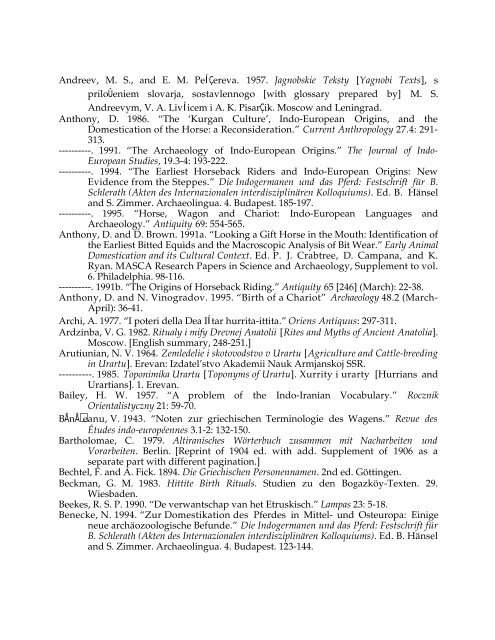Comparative Notes on Hurro-Urartian, Northern Caucasian
Comparative Notes on Hurro-Urartian, Northern Caucasian
Comparative Notes on Hurro-Urartian, Northern Caucasian
You also want an ePaper? Increase the reach of your titles
YUMPU automatically turns print PDFs into web optimized ePapers that Google loves.
Andreev, M. S., and E. M. PeÍÇereva. 1957. Jagnobskie Teksty [Yagnobi Texts], s<br />
priloÛeniem slovarja, sostavlennogo [with glossary prepared by] M. S.<br />
Andreevym, V. A. LivÍicem i A. K. PisarÇik. Moscow and Leningrad.<br />
Anth<strong>on</strong>y, D. 1986. “The ‘Kurgan Culture’, Indo-European Origins, and the<br />
Domesticati<strong>on</strong> of the Horse: a Rec<strong>on</strong>siderati<strong>on</strong>.” Current Anthropology 27.4: 291-<br />
313.<br />
----------. 1991. “The Archaeology of Indo-European Origins.” The Journal of Indo-<br />
European Studies, 19.3-4: 193-222.<br />
----------. 1994. “The Earliest Horseback Riders and Indo-European Origins: New<br />
Evidence from the Steppes.” Die Indogermanen und das Pferd: Festschrift für B.<br />
Schlerath (Akten des Internazi<strong>on</strong>alen interdisziplinären Kolloquiums). Ed. B. Hänsel<br />
and S. Zimmer. Archaeolingua. 4. Budapest. 185-197.<br />
----------. 1995. “Horse, Wag<strong>on</strong> and Chariot: Indo-European Languages and<br />
Archaeology.” Antiquity 69: 554-565.<br />
Anth<strong>on</strong>y, D. and D. Brown. 1991a. “Looking a Gift Horse in the Mouth: Identificati<strong>on</strong> of<br />
the Earliest Bitted Equids and the Macroscopic Analysis of Bit Wear.” Early Animal<br />
Domesticati<strong>on</strong> and its Cultural C<strong>on</strong>text. Ed. P. J. Crabtree, D. Campana, and K.<br />
Ryan. MASCA Research Papers in Science and Archaeology, Supplement to vol.<br />
6. Philadelphia. 98-116.<br />
----------. 1991b. “The Origins of Horseback Riding.” Antiquity 65 [246] (March): 22-38.<br />
Anth<strong>on</strong>y, D. and N. Vinogradov. 1995. “Birth of a Chariot” Archaeology 48.2 (March-<br />
April): 36-41.<br />
Archi, A. 1977. “I poteri della Dea IÍtar hurrita-ittita.” Oriens Antiquus: 297-311.<br />
Ardzinba, V. G. 1982. Ritualy i mify Drevnej Anatolii [Rites and Myths of Ancient Anatolia].<br />
Moscow. [English summary, 248-251.]<br />
Arutiunian, N. V. 1964. Zemledelie i skotovodstvo v Urartu [Agriculture and Cattle-breeding<br />
in Urartu]. Erevan: Izdatel’stvo Akademii Nauk Armjanskoj SSR.<br />
----------. 1985. Top<strong>on</strong>imika Urartu [Top<strong>on</strong>yms of Urartu]. Xurrity i urarty [Hurrians and<br />
<strong>Urartian</strong>s]. 1. Erevan.<br />
Bailey, H. W. 1957. “A problem of the Indo-Iranian Vocabulary.” Rocznik<br />
Orientalistyczny 21: 59-70.<br />
BÅnÅ eanu, V. 1943. “Noten zur griechischen Terminologie des Wagens.” Revue des<br />
Études indo-européennes 3.1-2: 132-150.<br />
Bartholomae, C. 1979. Altiranisches Wörterbuch zusammen mit Nacharbeiten und<br />
Vorarbeiten. Berlin. [Reprint of 1904 ed. with add. Supplement of 1906 as a<br />
separate part with different paginati<strong>on</strong>.]<br />
Bechtel, F. and A. Fick. 1894. Die Griechischen Pers<strong>on</strong>ennamen. 2nd ed. Göttingen.<br />
Beckman, G. M. 1983. Hittite Birth Rituals. Studien zu den Bo azköy-Texten. 29.<br />
Wiesbaden.<br />
Beekes, R. S. P. 1990. “De verwantschap van het Etruskisch.” Lampas 23: 5-18.<br />
Benecke, N. 1994. “Zur Domestikati<strong>on</strong> des Pferdes in Mittel- und Osteuropa: Einige<br />
neue archäozoologische Befunde.” Die Indogermanen und das Pferd: Festschrift für<br />
B. Schlerath (Akten des Internazi<strong>on</strong>alen interdisziplinären Kolloquiums). Ed. B. Hänsel<br />
and S. Zimmer. Archaeolingua. 4. Budapest. 123-144.





